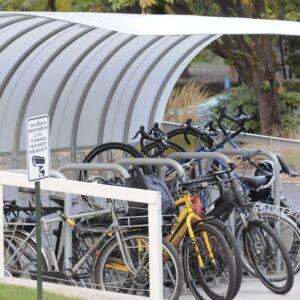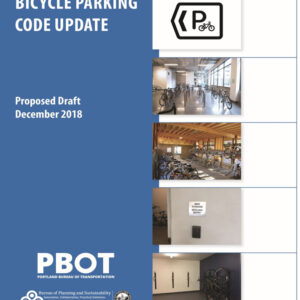“We can’t expect people to replace car trips with bike trips if they don’t have an easily accessible place to store their bike securely.”
— Chloe Eudaly, City Commissioner in charge of transportation
By this stage in the game, the vote on Portland’s bike parking code update was never in question. And even though I shared a more in-depth report when it appeared at council back in September, I feel like the adoption of policy this important should not go unnoticed here on the front page.
For the record, at their meeting this morning, Portland City Council voted 4-0 (Commissioner Jo Ann Hardesty was absent) to adopt a new set of bicycle parking regulations that will become local law for all new developments (and some major remodels).
Here’s a PBOT summary of what the new policy does:
➢ Enhance security standards to help prevent bike theft. During early public outreach, staff heard that bike theft and security are of great concern to Portlanders. Tightening the security requirements and removing some of the standalone options that are available in current code are intended to help ensure higher security in long-term bicycle parking.
Advertisement
➢ Increase options for space saving racks. Current code only addresses standards for horizontal (floor-mounted) rack placement and spacing. However, there are many rack designs that allow better use of space. Narrower spacing allows for greater flexibility in accommodating more bicycle parking in a smaller area.
➢ Usability for a variety of types of bicycles and people of all abilities. The Code’s requirements have not kept up with the types of bicycles people are riding today. Portland is seeing an increase in the use of electric bicycles and non-traditional sized bikes, including cargo bikes and recumbent tricycles. The proposed code amendments require bicycle parking that accommodates these bicycles and considers users of various abilities.
➢ Update the minimum required amounts of short– and long-term bicycle parking. The majority of the minimum required bicycle parking amounts have not been updated since 1996. Staff used a data driven formula based on data points, like average square footage per employee (long-term rates); visitation rates (short-term rates); and target bicycle mode split rates.
➢ Expand the use of geographic tiers to all Use Categories. While Portland has a citywide goal of 25% bicycle mode split for all trips, staff acknowledge that bicycle use rates will be different in various parts of the city, and that meeting the citywide goal will mean higher and lower rates depending on geography.
Advertisement
➢ Reduce the in-unit allowance for required long-term bicycle parking. The proposed code amendments represent a compromise position to limit the amount of required bicycle parking in a residential unit, and add some additional standards on how the in-unit racks can be placed to maximize accessibility and usability.
At today’s meeting, PBOT Commissioner Chloe Eudaly said, “The availability and design of bicycle parking has a real impact on whether people can choose to use a bike to travel around Portland or not. We can’t expect people to replace car trips with bike trips if they don’t have an easily accessible place to store their bike securely.” Eudaly added that she knows better bike parking isn’t the only thing we need to reach transportation and climate change goals. “Which is why I’m pleased,” she said, “that my Bureau has funding to build over 75 miles of bike facilities over the next five years.”
Mayor Ted Wheeler called the code’s adoption, “A win for the climate, a win for mobility, and a win for equity.”
Kudos to PBOT, the Portland Planning Commission, and all the agency staff and advocates who worked on this project. A special shout-out goes to Planning Commissioner Chris Smith for spearheading this effort from the start and seeing it through to the end.
— Jonathan Maus: (503) 706-8804, @jonathan_maus on Twitter and jonathan@bikeportland.org
— Get our headlines delivered to your inbox.
— Support this independent community media outlet with a one-time contribution or monthly subscription.







Thanks for reading.
BikePortland has served this community with independent community journalism since 2005. We rely on subscriptions from readers like you to survive. Your financial support is vital in keeping this valuable resource alive and well.
Please subscribe today to strengthen and expand our work.
“The availability and design of bicycle parking has a real impact on whether people can choose to use a bike to travel around Portland or not. We can’t expect people to replace car trips with bike trips if they don’t have an easily accessible place to store their bike securely.”
I could not have said it better myself and I am glad Eudaly gets it!
I often think some places designate bike parking as such afterthoughts that they end up making it easier for bike thieves to steal parked bikes.
Secure bike parking is a huge concern for me, and a major deterrent for me to ride my bike to certain potentially dicey areas if I end up having to park outside in the open. Even if your frame is secured, you have ensure your wheels, seat, and other items are also secured…it just becomes a pain.
I bought a Brompton for these scenarios… and for the most part if works–it’s still slightly annoying to lug that thing around and obviously the 16 inch wheels don’t result in the greatest ride quality, and the shifting a little clunky–but overall I have not much in the way of complaints.
We need to take a page from the auto industry and reduce the barrier to entry for biking. The auto industry realizes the easier it is to have and use a car, the easier it is to justify the expense. One way they’ve made car ownership easier is security: Modern cars are very difficult to steal–so people have fewer issues when driving a car places. Why don’t we have more effective ways of securing and dealing with bike theft? Accommodating more bikes in buildings with greater security is a good first step.
But, the thieves are always one step ahead of any security. About the only way to beat ’em is to ride a thrift-shop clunker to work and keep the good stuff for when you can keep it in sight at all times.
I feel that is a defeatist mentality–and one that will not serve bike advocates well in the future. Let’s not tell people already hesitant to use a bike that they are taking a gamble with their investment every-time they take their bike somewhere. Putting and mandating secure bike storage is a great first step towards securing bikes (and taking advantage of a bikes ability to be stored far more efficiently than a car)…but I’d like to see the day when bike-theft technology has evolved to a point makes the economics of stealing bikes unviable.
The bike industry is beholden to the consumer very much like auto industry, and that is why we can learn from their challenges, especially when it comes to security. Consider a mid-90s Subaru Outback. I can order a key for a mid-90s Subaru Outback, find a random other mid-90s Subaru Outback, and should be able to just to unlock and start the car up and drive off. Anti-theft technology has evolved so much in the last twenty years, that stealing a car is incredibly difficult to do (and why a lot of stolen cars these days are older models). If Subaru’s outlook at the time was “Well…thieves will always be one step ahead of security” they’d be out of business.
And owning a beater bike is good advice, I think the joy of riding a bike is the idea of riding something that is ultimately your own and an expression of your personality. It’s human nature to want to customize and make it your own. Bikes connect you more to the ground and surrounding and environment–all the more reason to have the performance and handling that will make you want to ride your bike (e.g. upgrading wheels aren’t cheap, but make a huge difference in the enjoyment and rideability of your bike).
I want people to get excited about riding a bike, and take away as many concerns as possible about doing so as possible.
The big difference is that cars are $20,000+, and are essentially a steel/glass box. It’s a lot easier to design security for an expensive 4,000lb steel/glass box.
How do you secure a sub-$1,000 item that can be easily carried away or loaded into a vehicle, with removable/serviceable parts? That’s quite the engineering challenge.
Most cars these days are a combination of mechanical and (increasingly more) electrical components. As a cursory thought: We’d probably need to add electrical components into bike frames for elements related to security (maybe an electronic tracker, or a built in lock with a recommended manual lock–just throwing ideas out), while keeping the core drivetrain mechanical. Obviously this means extra weight and plugging in at night. Most people are getting plug-in cars though, so I feel plugging in a bike shouldn’t be a burden. Maybe even a more consistent way to register bikes rather than serial numbers?
I’m just throwing out ideas…that might be debunked easily but I simply don’t see how we can increase ridership without solving the issue of bike security. I bring up the auto-industry as their mentality (for better or worse) is to take the worry out of owning a car and if we want serious consideration as bike as a viable commuting option, we need to be doing the same. The auto industry have made cars essentially associated with practicality. Let’s take a page out of that playbook…because at the end of the day more people will ride bikes and to more destinations as a practical measure.
I can go on about the freedom and maneuverability of riding a bike, the immense sense of solidarity you feel with fellow riders when you are commuting by bike that you just can’t get in a car. Then again, I am not the one bike advocates are trying to convince.
Can you imagine if someone suggested that car-owners deal with theft and vandalism by having (in addition to their nice car) an old junker that nobody would want to mess with for daily driving?
I wish this had been implemented prior to the apartment building boom that kicked off six or seven years ago. It seems to be slowing down so I fear that this may have come a bit late. I’m still happy that it has passed, though.
I checked my calendar and the first meeting I had with PBOT and BPS staff together in one room on this was in 2013 🙂
I got excited seeing the headline but was hoping for something like this… https://www.nytimes.com/2019/12/04/nyregion/nyc-cargo-bikes-delivery.html?action=click&module=News&pgtype=Homepage
I don’t care how secure they think the room or the mounts are, I don’t trust them. I don’t trust my bike being parked anywhere overnight that a stranger can see it.
If they want to ensure that less bikes get stolen they need to mandate that all property owners must allow bicycles into all residential buildings.
Unless it’s in my personal shed/garage/house then it’s not secure enough to leave overnight.
Seems like the in-unit “bike nook” allowed under this code is exactly what you want. I’m honestly not sure if units with in-unit bike parking will command a premium, or will just be used to stack boxes. Or even whether developers will really build many. It’s going to be interesting to watch what developers do within what’s allowed.
Hey, Chris, great work!
Keep on going, man, we need you!
Thanks Chris! How can we get you nominated to the OTC?!? They need help badly over there.